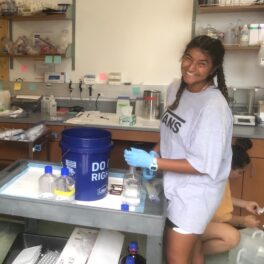Study finds novel, abundant nitrogen-fixing microbes in surface ocean
 Rappe Lab graduate student Sarah Tucker sampling in Kaneohe Bay. Credit: Jessica Schaefer.
Rappe Lab graduate student Sarah Tucker sampling in Kaneohe Bay. Credit: Jessica Schaefer.
Move over, cyanobacteria! A large-scale study of the Earth’s surface ocean, co-authored by Michael Rappé, professor at the University of Hawai‘i at Mānoa School of Ocean and Earth Science and Technology (SOEST), indicates the microbes responsible for fixing nitrogen there — previously thought to be almost exclusively photosynthetic cyanobacteria–include an abundant and widely distributed suite of non-photosynthetic bacterial populations.
Nitrogen fixation is a critical ecological process in which atmospheric nitrogen is converted to ammonia, making nitrogen “bioavailable” to living organisms to use as a fundamental building block of DNA, RNA and proteins.
“Microbes that can fix nitrogen or carbon are at the center of the ecology of microbial communities in many environments, including the surface ocean,” said lead author Tom O. Delmont of the University of Chicago.
Using anvi’o, a state-of-the-art, open-source bioinformatics platform to analyze metagenomes (the pool of DNA sequences that represent all the microbial organisms found in an environment), the team revealed insights into previously unknown marine microbes with nitrogen fixation capabilities affiliated with Proteobacteria as well as Planctomycetes, a prevalent bacterial phylum that has never before been linked to nitrogen fixation.
These newly described microbial populations occur widely and are particularly abundant in the Pacific Ocean, where they average an estimated 700,000 cells per liter of seawater and up to 3 million cells per liter — orders of magnitude more than previous estimates for non-cyanobacterial nitrogen fixers in the open ocean.
Using data generated from the Tara Oceans expedition from 2009 to 2013, the research team, led by A. Murat Eren (Meren) of the University of Chicago and the Marine Biological Laboratory (MBL), Woods Hole, and Tom O. Delmont of the University of Chicago, reconstructed about 1,000 microbial genomes from more than 30 billion short metagenomic sequences. Of those 1,000 genomes, nine contained the six genes that are required for nitrogen fixation, and yet lacked the genes needed for photosynthesis. This is the first genomic database of non-photosynthetic microorganisms inhabiting the open ocean and capable of fixing nitrogen.
Because the team reconstructed and used near-complete genomes for their investigation (rather than using a single marker gene for nitrogen fixation), they could identify the class of microbes to which these nitrogen-fixing populations belong. They also determined their abundance and distribution patterns in the oceans and seas from which the samples came (the Atlantic, Pacific, Indian and Southern Oceans and the Mediterranean and Red Seas).
“We can now use these population genomes to guide the laboratory cultivation of nitrogen-fixing Planctomycetes and Proteobacteria from the open ocean,” Delmont said. “This will help us understand the conditions in which they fix nitrogen, the complexity of their functional lifestyles, and other aspects of their ecology that we cannot comprehend by just looking at their genomes, genes and inferred functions.”
“This study is another example of how resolving genomes directly from the DNA of entire microbial communities is transforming our understanding of microbial diversity,” said co-author Christopher Quince of the University of Warwick, United Kingdom.
* * *
Content based on materials provided by Marine Biological Laboratory.




